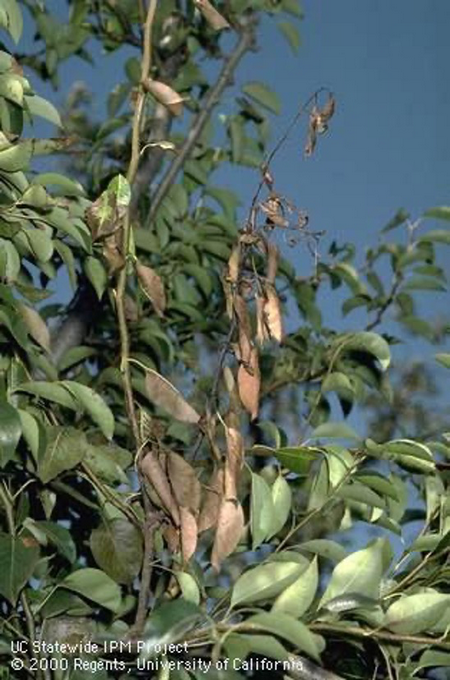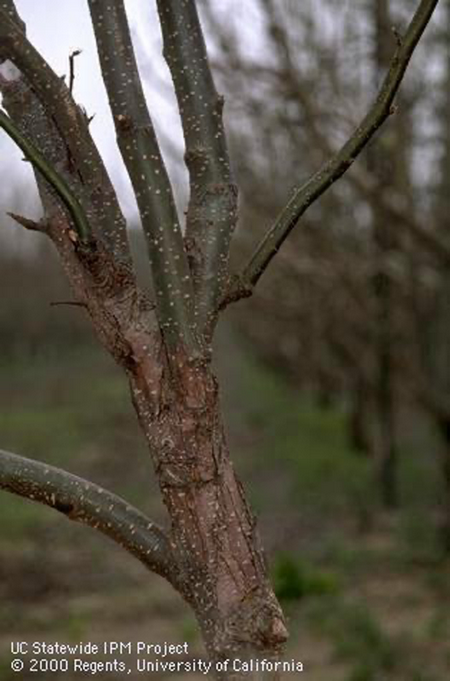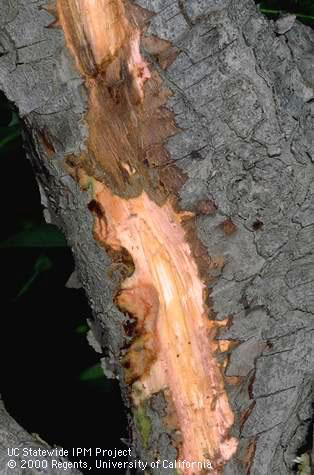Help! My Apple and Pear Trees are Burning Up!
Have you noticed burnt-looking blossoms and twigs on your apple, pear, or quince trees? This is likely caused by a bacterial infection, appropriately named fire blight. Fire blight can damage and even kill fruit trees in the Pome family and may affect other related species such as crabapple, ornamental pear, pyracantha, and toyon. It does not affect stone fruit, such as plum, peach, apricot, or cherries.
The disease is caused by a bacterium, Erwinia amylovora, which is most active during warm, wet spring weather. It enters the plant primarily through blossoms, but also through tender new shoots or bark wounded by mechanical injury or from strong hail and wind. It is spread by splashing water and pollinating insects, including bees. The pathogen is widespread in the environment but may not be much of a problem unless conditions are favorable. Older established trees can often withstand some fire blight damage, but young trees may be severely damaged.
The first sign of a fire blight infection may be dark and dried-up new shoots and young fruit, which soon turn black. You might also see watery, amber-colored droplets oozing from affected areas.
Fire blight may sometimes be confused with another condition, blossom blast, which also produces blackened flower clusters, but there are several symptoms characteristic of fire blight. On apples and pears, the tips of affected shoots develop a curved tip (‘Shepherd's Crook'). The scorched-looking young leaves and fruit do not fall off, but cling to the plant.
If a new fire blight infection is not removed in time, it spreads down through the wood, and bark cankers (areas of dead, discolored tissue) develop. If not removed, the infection in these areas persists from year to year.
Fire blight is not easy to control, but there are a few things you can do to manage this disease. Examine your trees regularly so you notice the first signs of a strike; the new shoots start to turn brown and droopy even before they become black. These shoots should be removed right away, cutting far enough below the infection to where no brown or discolored areas are seen. Use sharp pruners, disinfecting them between each cut. Use a 10% bleach solution or Lysol for disinfecting.
The disease becomes inactive during the summer and winter when bark cankers harboring the pathogen may be seen. These can be removed by pruning out diseased wood, at least 6–10 inches below the visible infection, or back to the branch connection with a larger branch or the trunk. If the canker is on a large limb or the trunk but does not girdle the branch, you can try scraping the bark away until no more discoloration is seen. Dispose of all infected material in the trash and not in the compost!
When fire blight is a problem from year to year, you can use a copper spray on the blossoms. This helps to prevent new infections but is not very effective if the pathogen is already in the tree. Such sprays can also cause russeting damage on the fruit.
When planting new trees, consider varieties that are more resistant to fire blight such as Arkansas Black or Cox's Orange Pippin. Unfortunately, many of our favorite varieties such as Pink Lady and Fuji, and most pears, are very susceptible. Tender new growth on a tree is more likely to suffer, so avoid practices that encourage this such as excess fertilizing and pruning. Also, don't irrigate while the tree is blooming.
This UC website provides more detailed information on fire blight and how to manage it.
https://ipm.ucanr.edu/PMG/PESTNOTES/pn7414.html
Help Desk of the UC Master Gardeners of Contra Costa County (SMW)




